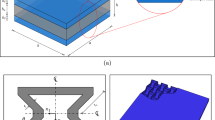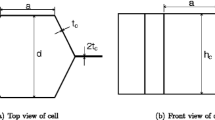Abstract
An equivalent modeling method for honeycomb sandwich structure is presented in this paper. Honeycomb core is regarded as an interlayer and orthogonal anisotropic solid elements are used to model it, while the panels of honeycomb sandwich structure are represented by shell elements. This method not only controls model size and ensures computational efficiency, but also solves the problem that two-dimensional model cannot represent the internal stress distribution and local deformation. Based on the orthogonal anisotropy of honeycomb and the actual cellular size, 9 independent elastic parameters of the interlayer are given, so that the physical properties of the interlayer are described completely. In the example, the displacement errors under typical static loadcases are less than 3.12% and the frequency errors of the first six orders are less than 4.07%, compared with the precise model. A modal tapping test was carried out on a payload mounting panel with honeycomb sandwich structure. By comparing the test data with the analysis data of the equivalent model, it was shown that the frequency errors of the first six orders were all within 5%, and the analysis modes were consistent with the experimental fitting modes, which further verified the validity of the equivalent method.









Similar content being viewed by others
References
Lim J, Lee D (2011) Development of the hybrid insert for composite sandwich satellite structures. Compos Part A 42:1040–1048
Dong J, Zhu G (2016) Mechanical analysis and bionic structure design of astronautic payloads based on natural honeycomb. J Astronaut 37(3):262–267 (in Chinese)
Schafer K, Gohler C, Troltzsch J et al (2019) Textile-based surface design of thermoplastic composites for microstructural adhesion to polyurethane foams for lightweight structures. Compos Interfaces 26(4):339–356
Kim B, Lee D (2010) Development of a satellite structure with the sandwich T-joint. Compos Struct 92:460–468
Watarai H, Katayama H, Tadono T et al (2018) Current development status of the wide-swath and high-resolution optical imager onboard advanced optical satellite (ALOS-3). Proc SPIE 10785:107850P
Blecha L, Zindel D, Cottard H et al (2016) Analytical optimization and test validation of the sub-micron dimensional stability of the CHEOPS space telescope’s CFRP structure. In: Proc. of SPIE, vol 9912, p 99121G
Tanimoto Y, Nishiwaki T, Shiomi T et al (2001) A numerical modeling for eigenvibration analysis of honeycomb sandwich panels. Compos Interfaces 8(6):393–402
Guj L, Sestieri A (2007) Dynamic modeling of honeycomb sandwich panel. Arch Appl Mech 77:779–793
Jiang D, Zhang D, Fei Q et al (2014) An approach on identification of equivalent properties of honeycomb core using experimental modal data. Finite Elem Anal Des 90:84–92
Qin Y, Kong X, Luo W (2011) RSM-based FEM model updating for a carbon fiber honeycomb sandwich panel. J Vib Shock 30(7):71–76 (in Chinese)
Cho H, Rhee J (2011) Vibration in a satellite structure with a laminate composite hybrid sandwich panel. Compos Struct 93:2566–2574
Zhang T (2011) Analysis of sandwich structure and research of structural design for satellite. Nanjing University of Aeronautics and Astronautics, Nanjing, pp 15–25 (in Chinese)
Gibson LJ, Ashby MF (1988) Cellular solids, structure and properties. Pergamon Press, London
Gibson LJ, Ashby MF, Schajer GS et al (1982) The mechanics of two-dimensional cellular materials. Proc R Soc Lond Ser A 382:25–42
Burton WS, Noor AK (1997) Assessment of continuum models for sandwich panel honeycomb cores. Comput Methods Appl Mech Eng 145:341–360
Fu M, Yin J (1999) Equivalent elastic parameters of the honeycomb core. Acta Mech Sin 31(1):113–118 (in Chinese)
Fu M, Xu O, Chen Y (2015) An overview of equivalent parameters of honeycomb cores. Materials Review 29(3):127–134 (in Chinese)
Kelsey S, Gellatly RA, Clark BW (1958) The shear modulus of foil honeycomb cores. In: Aircraft engineering, pp 294–302
Funding
The National Key Research and Development Program of China (2016YFB0500904).
Author information
Authors and Affiliations
Corresponding author
Additional information
Publisher's Note
Springer Nature remains neutral with regard to jurisdictional claims in published maps and institutional affiliations.
Rights and permissions
About this article
Cite this article
Yuan, J., Zhang, L. & Huo, Z. An Equivalent Modeling Method for Honeycomb Sandwich Structure Based on Orthogonal Anisotropic Solid Element. Int. J. Aeronaut. Space Sci. 21, 957–969 (2020). https://doi.org/10.1007/s42405-020-00259-6
Received:
Revised:
Accepted:
Published:
Issue Date:
DOI: https://doi.org/10.1007/s42405-020-00259-6




